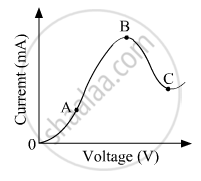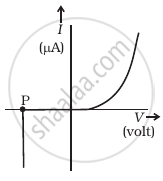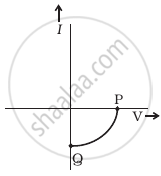Advertisements
Advertisements
प्रश्न
In the circuit shown in figure, if the diode forward voltage drop is 0.3 V, the voltage difference between A and B is ______.

विकल्प
1.3 V
2.3 V
0
0.5 V
उत्तर
In the circuit shown in figure, if the diode forward voltage drop is 0.3 V, the voltage difference between A and B is 2.3 V.
Explanation:
Let us consider figure 2.3 V given above in the problem, suppose the potential difference between A and B is VAB.
Then, `V_(AB) - 0.3 = [(r_1 + r_2)10^3] xx (0.2 xx 10^-3)` .....[∵ VAB = ir]
= `[(5 + 5)10^3] xx (0.2 xx 10^-3)]`
= `10 xx 10^3 xx 0.2 xx 10^-3`
= 2
⇒ VAB = 2 + 0.3 = 2.3 V
APPEARS IN
संबंधित प्रश्न
With the help of neat labelled circuit diagram explain the working of half wave rectifier using semiconductor diode. Draw the input and output waveforms.
The graph shown in the figure represents a plot of current versus voltage for a given semiconductor. Identify the region, if any, over which the semiconductor has a negative resistance.

A triode value operates at Vp = 225 V and Vg = −0.5 V.
The plate current remains unchanged if the plate voltage is increased to 250 V and the grid voltage is decreased to −2.5 V. Calculate the amplification factor.
What are the applications of p - n Junction diode?
The drift current in a p-n junction is from the ______.
When an electric field is applied across a semiconductor ______.
- electrons move from lower energy level to higher energy level in the conduction band.
- electrons move from higher energy level to lower energy level in the conduction band.
- holes in the valence band move from higher energy level to lower energy level.
- holes in the valence band move from lower energy level to higher energy level.
Consider an npn transistor with its base-emitter junction forward biased and collector base junction reverse biased. Which of the following statements are true?
- Electrons crossover from emitter to collector.
- Holes move from base to collector.
- Electrons move from emitter to base.
- Electrons from emitter move out of base without going to the collector.
 (a) |
 (b) |
- Name the type of a diode whose characteristics are shown in figure (A) and figure (B).
- What does the point P in figure (A) represent?
- What does the points P and Q in figure (B) represent?
The graph of potential barrier versus width of depletion region for an unbiased diode is shown in graph A. In comparison to A, graphs B and C are obtained after biasing the diode in different ways. Identify the type of biasing in B and C and justify your answer
| ‘A’ | ‘B’ | ‘C’ |
 |
 |
 |
Explain the formation of the barrier potential in a p-n junction.
